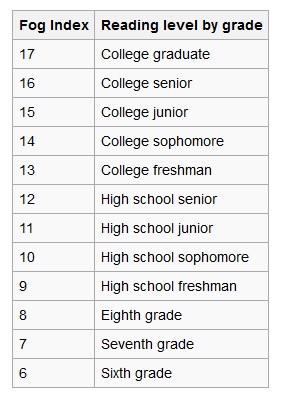In linguistics, the Gunning fog index measures the readability of English writing. The index estimates the years of formal education needed to understand the text on a first reading. A fog index of 12 requires the reading level of a U.S. high school senior (around 18 years old). The test was developed by Robert Gunning, an American businessman, in 1952.
The fog index is commonly used to confirm that text can be read easily by the intended audience. Texts for a wide audience generally need a fog index less than 12. Texts requiring near-universal understanding generally need an index less than 8.

Calculation
The Gunning fog index is calculated with the following algorithm:
1. Select a passage (such as one or more full paragraphs) of around 100 words. Do not omit any sentences;
2. Determine the average sentence length. (Divide the number of words by the number of sentences.);
3. Count the "complex" words: those with three or more syllables. Do not include proper nouns, familiar jargon, or compound words. Do not include common suffixes (such as -es, -ed, or -ing) as a syllable;
4. Add the average sentence length and the percentage of complex words; and
5. Multiply the result by 0.4.
The complete formula is:
